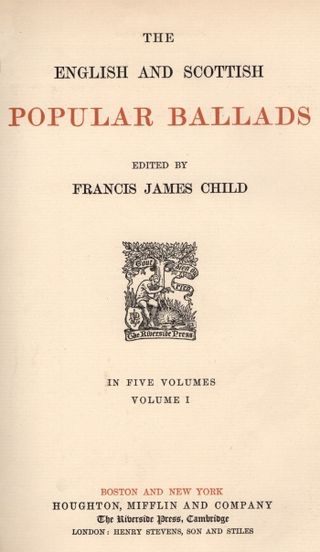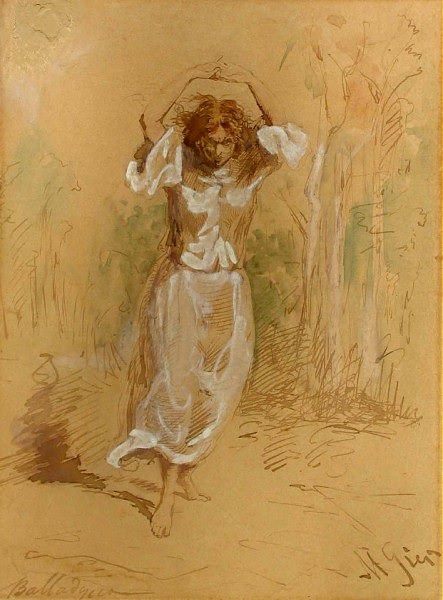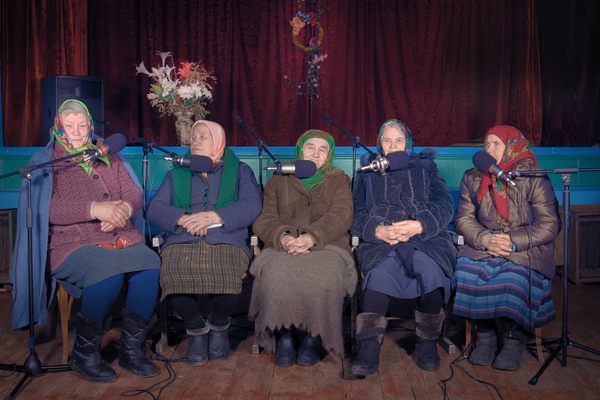How 2 Sisters and 1 Murder Inspired 500 Songs

The ballad “The Two Sisters” tells the story of an older sister murdering her younger sister by drowning. (Photo: Public Domain/WikiCommons)
Around a fire in the not-so distant past, listeners in Northern Europe might have settled in to listen to a song about a man wooing a woman in a seaside village, giving her tokens of affection and promising to marry her. But the song, which lilts in gentle rhyme, takes a quick and morbid turn: she’s murdered.
The corpse is soon found; the young woman’s bones and hair, freshly plucked from the her body, are made into a harp. When the ghastly instrument is brought to the wedding of the woman’s lover and her killer—her own sister—it sadly and mysteriously sings on its own.

This may sound like a bizarre soap opera plot, but for hundreds of years people sang this dark fairytale on stages, around fires and in taverns–and still do. One of the many names the song has gone by is “The Twa Sisters,” and it is one of the strangest love-and-murder ditties in existence. The tale of the two sisters and their musical bone harvesting has crossed borders, oceans, and cultures, with more than 531 versions of the ballad currently logged in countries all around the world, according to the Roud Folk Song Index, which catalogs traditional songs. But how did such a macabre song originate? And how did it become so wildly popular?
“These tales of marvel, love and butchery, told in a style strikingly distinct from that of most poetry, appeal to a diverse audience, but yet provoke questions which have never been satisfactorily answered,” writes ballad scholar David Buchan in The Ballad and the Folk.
Different versions of “The Twa Sisters” play on these themes according to the local tradition they came from, and vary slightly in the lyrics and melody used. The song’s story always begins with a similar premise: two sisters are in competition, usually over a male admirer, and when the younger sister seems to be winning, the older sister kills her in cold blood by throwing her into a body of water. Sometimes the lover woos the older sister first, only to unfairly pursue the younger woman; other times the oldest is jealous from afar as she plans to kill her sister, which somehow entitles her to the man herself.
Typically the older sister is sociopathic; in the guise of spending some quality time by the sea (or river, or pond) together, she brings her younger sister to the murder scene. Sometimes, the younger sister is saved by the miller at his dam only to be killed by him later, when her sister shows up and bribes him with golden rings.
The tale of “The Twa Sisters” was first catalogued by ballad collector Robert Jamieson in 1806 in Scotland. It was already a popular song by that time, however. Its oldest incarnations, along with other murder songs called “murder ballads”, were widely distributed on broadsides, single pieces of papers with a song, picture, or news snippet printed on one side, and sold for cheap beginning in the 1400s.
The Twa Sisters, in particular, hits some of the cruelest notes in our culture: family jealousy, inadequacy in love, irrevocable revenge gone wrong. The first English printing of the ballad’s lyrics dates back to 1656, when a song by the name of “The Miller and the King’s Daughter” appeared, though that version lacks a clear motive for the murder.
Today “The Twa Sisters” exists in so many forms, lyrically and musically, that it might be impossible to name all of its titles, which include “Binnorie”, “Minnorie”, “The Miller’s Daughter”, “The Bonnie Swans”, “The Cruel Sister”; the list goes on. As its many titles suggest, the ballad has a farther-reaching history than the 17th century United Kingdom. Likely many more versions of the song existed throughout history, beyond the more than 500 in the Roud Folk Song Index.

The 1904 edition of Child’s English and Scottish Popular Ballads. (Photo: Public Domain/WikiCommons)
This horrific murder story was so popular over the years that the Child Ballads, a collection of 305 traditional folk ballads compiled by Francis James Child in the late 19th century, included 21 English versions of the Twa Sisters song. In his collection and book, Child notes that versions of the song appear in Danish, Swedish, English, and Norwegian and Icelandic languages. Over 125 variants exist in Swedish, and these Scandinavian versions tend to include a supernatural and gruesome twist: the corpse of the younger sister is found, and someone creates a harp or fiddle of her breastbone and long blond hair.
Child occasionally found this in English, too:
A famous harper passing by,
The sweet pale face he chanced to spy.
And when he looked that ladye on,
He sighed and made a heavy moan.
He made a harp of her breast-bone,
Whose sounds would melt a heart of stone.
The strings he framed of her yellow hair,
Whose notes made sad the listening ear.”
In this case, usually the morbid harp just sings of the sad circumstance of her death, and hints at whose voice is singing. If ripping out a dead girl’s breast bone and hair to fashion a harp isn’t gross enough, though, Child has some even more vengeful versions in his collection. These songs give the elder sister a taste of her own medicine in a horrific fashion. In Danish, Swedish, and Norwegian, the murderess is burned to death, and is very rarely saved by the younger sister, who in some versions comes back to life and merely sends her away.
“Nevertheless,” writes Child, “she is burned alive in [version] L, which is her fate also in E, and in other unprinted versions. A prose comment upon Danish I has her stabbed by the bridegroom.” Other versions describe that, after the harp sings, the oldest sister’s heart actually explodes, killing her. At this point, you almost feel bad for the cruel sister.
While there is no description of how these songs crossed early cultural boundaries, the similarities of the songs are clear. Buchan call this “a peculiar lack when one considers Scandinavia is undeniably the British tradition’s nearest sibling” and thinks that the 1266 Treaty of Perth between Scotland and Norway may show thriving relations between the two cultures, in which case stories like “The Twa Sisters” could go back even farther than we think.
Today, English versions abound. The song, along with other old ballads from the UK, made its way to American folk music with the influx of settlers in the south and west. These versions have simpler, grittier lyrics, but drop the bone harvesting details and end the song on a more realistic note: that the oldest sister gets away with it. A version by Horton Barker in Anglo American Ballads Vol II, omits the harp and provides no payback for the evildoings. Some of the old supernatural theme survives, though, in the country-folk song “The Wind And the Rain”:
He a made a fiddle peg of her long finger bone, crying
Oh, the dreadful wind and rain
And he strung his fiddle bow with her long yeller hair
Oh, the wind and the rain”
As many of the broadside ballads were recorded without sheet music, it’s interesting to note that while the lyrics are well documented, its original melody is a bit of a mystery. Paul Clayton, mentor to Bob Dylan, has a version that sounds cheerful, almost calming, despite ending the song without retribution for the younger sister; Tom Waits’ “Two Sisters” is sung roughly with accompaniment by a lone violin; 20th-century English folksinger Ewan MacColl played “Minnorie” with quick, upward guitar work.

An illustration of Balladyna, circa 1868. (Image: Maksymilian Gierymski/Public Domain)
While the song was growing and morphing through music, the story permeated other mediums. Details, like the man’s name being William, are added in English Fairy Tales (1890), and in 1830s Poland, the tragedy Balladyna fleshes the theme out to an entire play. In Balladyna, the two sisters have a raspberry-picking contest to compete for a rich prince, which causes the older sister to stab her younger sister with a knife, despite already having a beau of her own. She’s cursed with a permanent blood stain on her forehead, and generally continues to be horrible until she is finally stricken by God himself. In 1920, a variation of the Twa Sisters story was made into an opera. By 2012, it had become an indie film.
Why do all the variants exist? Over time, folk music and ballads like these became part of local oral tradition. “Humans invent songs and stories so that they can be repeated,” music critic Dave Marsh writes in the anthology, The Rose & the Briar: Death, Love and Liberty in the American Ballad. “Their endless variation should surprise us no more than the endless variation of each face we see.”
The simplicity and shock of murder ballads like The Twa Sisters gets right to the dark side of human behavior, the kind we all know exists, but can’t quite make sense of. What drives a person to murder? What happens when you fear loneliness, or are forever cut off from love?
These questions captivate us, and the same fears and feelings, in all their forms, are immortalized in verses that continue to crop up all around the world. While we’ll never know exactly where and when “The Twa Sisters” began, as long as people keep falling in love and dealing with our inescapable mortality, they will continue to sing about it.










Follow us on Twitter to get the latest on the world's hidden wonders.
Like us on Facebook to get the latest on the world's hidden wonders.
Follow us on Twitter Like us on Facebook